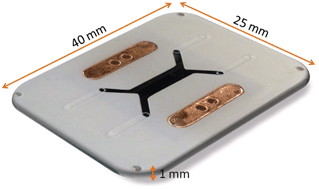Membraneless glucose/O2 microfluidic enzymatic biofuel cell using pyrolyzed photoresist film electrodes†
Abstract
Biofuel cells typically yield lower power and are more difficult to fabricate than conventional

* Corresponding authors
a
Instituto de Microelectrónica de Barcelona, IMB-CNM (CSIC), Campus de la Universidad Autónoma de Barcelona (Esfera UAB), 08193-Bellaterra, Barcelona, Spain
E-mail:
javier.delcampo@csic.es, neus.sabate@imb-cnm.csic.es
Fax: +34 93 5801496
Tel: +34 93 5947700
b
Departments of Chemistry and Materials Science and Engineering, University of Utah, 315 S 1400 E Rm 2020, Salt Lake City, UT 84112, USA
E-mail:
minteer@chem.utah.edu
Fax: (801) 581-8433
Tel: (801) 587-8325
Biofuel cells typically yield lower power and are more difficult to fabricate than conventional

 Please wait while we load your content...
Something went wrong. Try again?
Please wait while we load your content...
Something went wrong. Try again?
M. J. González-Guerrero, J. P. Esquivel, D. Sánchez-Molas, P. Godignon, F. X. Muñoz, F. J. del Campo, F. Giroud, S. D. Minteer and N. Sabaté, Lab Chip, 2013, 13, 2972 DOI: 10.1039/C3LC50319D
To request permission to reproduce material from this article, please go to the Copyright Clearance Center request page.
If you are an author contributing to an RSC publication, you do not need to request permission provided correct acknowledgement is given.
If you are the author of this article, you do not need to request permission to reproduce figures and diagrams provided correct acknowledgement is given. If you want to reproduce the whole article in a third-party publication (excluding your thesis/dissertation for which permission is not required) please go to the Copyright Clearance Center request page.
Read more about how to correctly acknowledge RSC content.
 Fetching data from CrossRef.
Fetching data from CrossRef.
This may take some time to load.
Loading related content
